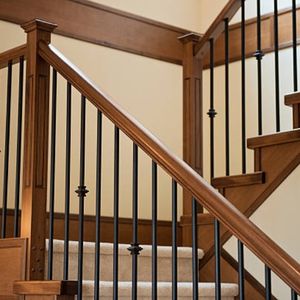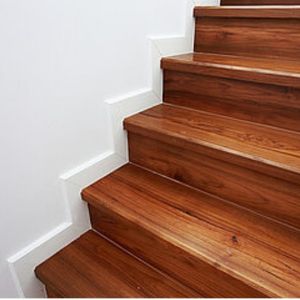Handrails support us when walking on the stairs. They protect us from falling off the stairs. They are made of iron and can be attached to balusters or to the wall.
Handrails run from the top of the stairs to the end. If you are constructing your home and you have gotten to the staircase, the question you will ask is, Where should a handrail start and stop?
Before you conclude on how you want to build your stairs, you should check the building code in your area. The guidelines will give you information on how the handrails should be installed. You will find out the length and height of the handrails should be.
When it comes to residential areas, the handrail must comply with ADA (Americans with Disabilities Act) and IBC (International Building Code) guidelines.
According to the Americans with Disabilities Act (ADA) and International Building Code (IBC), the handrail must be continuous; it must start at the nosing of the last step up to the nosing of the first step. It must be the same length as the nosing line.
According to this act, in commercial buildings, the handrails must have additional 12 inches at the top on the upper nosing.
Your handrails must also be installed in compliance with the guidelines of OSHA (Occupational Safety and Health Administration)
Table of Contents
Should Handrails Be Continuous When Installing Them?
When installing handrails, it must be continuous. Safety should be our priority. No matter the number of stairs, the railings should be continuous.
According to most building codes in different municipalities, the handrails must be continuous; they can not stop in the middle because there would be nothing to hold on to.
Where Should a Handrail Start?
As I mentioned earlier, the handrail should start at the nosing of the top step. It shouldn’t move slower than the top step. This is so that anyone walking on the stairs would have something to hold on to from the top down to the last lower step.
Where Should a Handrail Stop?
In residential areas, the handrail should stop at the lowest step. But in commercial areas, additional inches can be added to it but it shouldn’t pose any risk. The idea is just for proper safety against falls which can cause injury.
How Do You Start a Handrail?
You can install a prefabricated handrail yourself rather than calling a carpenter to do that. You will need the following:
- Pre-milled handrail
- 3 handrail brackets
- 2 ½ inch stainless steel wood screws with the following materials:
- Stud finder
- Pencil
- Measuring tape
- Carpenter’s level
- Miter saw
- Screwgun
- Drill, and
- Bits.
To start installing a handrail, you should find the studs at the handrail bracket location using a stud finder. The brackets shouldn’t be more than 4 feet apart. The brackets should be 1 foot from the top and bottom of the handrail.
The handrail would be sturdier based on the brackets you installed. Vertical reference lines on the walls should be used to indicate the center of each stud.
Cut the handrail to the length you desire but it should extend beyond the top and bottom steps. Measure the height of the handrail also.
The height should be between 34 – and 38 inches. Mark the wall at the desired inches above the nose of the stair treads.
How Do You End a Handrail?
After marking where the handrail brackets would be, attach them to the wall. The bottom edge of the handrail must be flush with the top of the brackets. After attaching the brackets, let the handrail rest on the bracket.
There should be a correct overhang at the top and bottom. Secure the handrail to the brackets with the U-shaped sleeves. Screw the sleeves tightly to the handrail.
Which Side Should Handrails Be on the Stairs?
This is actually dependent on the kind of stairs you have and also the convenience of those walking on the stairs. The handrail can be on any side but it must be continuous. For disabled people, the handrails must be on both sides.
Many people prefer to put the handrail on the right side so that one can hold it with one’s right hand which is known as the dominant hand.
But what if my left hand is my dominant hand? Handrails can be on either side. If your stairs are connected to the wall, then the handrail should be on the open side.
Do I Need a Handrail on Both Sides?
The handrail must be on one side of the stairs. It is mandatory for the stairs to have handrails due to safety reasons. Especially if one side of the stairs is opened, a handrail should be there.
Having handrails on both sides is optional. But according to ADA, you should have handrails on both sides because of disabled people.
Can a Railing Stop at the Bottom of the Stairs?
The railing is a continuous barrier that prevents people from falling on the stairs. It is different from the handrail.
For safety reasons, the railing should stop at the bottom of the stairs. It prevents people from falling at any point on the stairs. It must also be strong enough to remain in its position when pushed.
Benefits of Handrails for Stairs
1. Support
One of the benefits of a handrail for stairs is that it gives support to those walking on it. While you are going up or coming down the stairs, you need support, especially for your hand.
This support gives you balance you walk on the stairs. People that have mobility problems will really need handrails for support.
2. It can Substitute for Railings
Most residential areas only have handrails on the stairs; they don’t have railings. Handrails can function as railings. Handrails prevent people from falling when they miss a step or lose their balance.
3. It Provides Stability during Cold Weather
During spring and winter, every part of the house is cool and certain areas are always slippery due to dampness. The stairs are one place that is always slippery during these seasons.
Not having a handrail on the stairs is risky because one can lose one’s life during a fall. Check out: How to End Baseboard at Stairs
Conclusion
You can’t build a house without a handrail for the stairs except if the stair is just two to three steps. During an inspection, the inspector will call your attention to it. You don’t have to rely on a carpenter to install a handrail, you can do it yourself. Handrails add visual effects to your home especially when the color matches the colors in the room.









